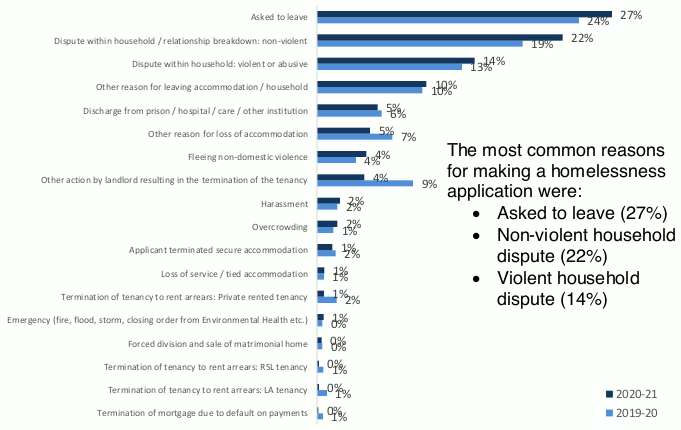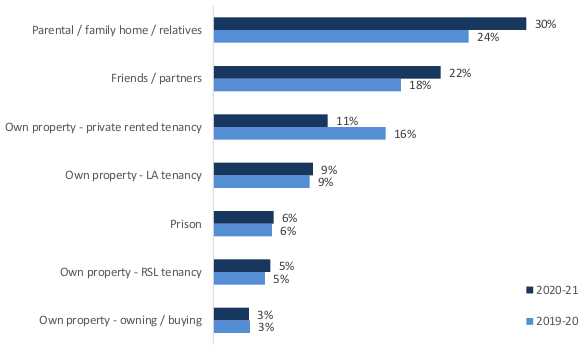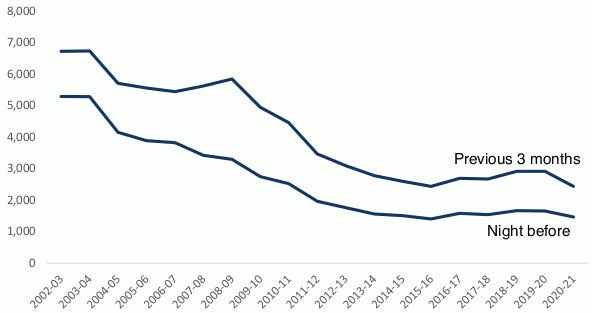Homelessness in Scotland: 2020 to 2021
This statistics bulletin provides information on homelessness in Scotland in the period from 1 April 2020 to 31 March 2021, alongside historical data.
Reasons for Homelessness and Prior Circumstances
Why do households make a homelessness application?
There were notable differences in the main reason given for making a homelessness application during 2020/21 compared to 2019/20.

The increases in the proportions presenting as homeless for reasons of ‘being asked to leave’ and household disputes (both violent and non-violent) tie in with the increase in proportion of those noting ‘Lack of support from friends/ family’ as an additional reason (21% to 25%). (Table 6)
The decreases in loss of accommodation reasons are likely due to temporary measures introduced to protect renters over the COVID-19 period, including the use of extended notice periods for eviction proceedings as noted earlier[7]. In addition, mortgage payment deferrals were introduced across the UK in March 2020 to allow customers experiencing issues paying their mortgage during the COVID-19 pandemic to apply for a break in making mortgage payments for a period of up to 6 months, alongside a temporary ban on home repossessions[8]. This also follows in the additional reason of financial difficulties / debt / unemployment dropping from 18% to 14%. (Table 6)
What are the prior circumstances of the homeless population?
As part of the application process information is gathered on where the household became homeless from.

The high proportions of households becoming homeless from friends and family ties in with the high levels of reasons given as dispute within household / relationship breakdown seen previously. Similarly, the decrease in proportion from private rented tenancies are linked to the ban on evictions noted earlier.
Chart 9 shows how many households who made a homelessness application in 2020/21 reported previous experience of rough sleeping.

1,471 households (4% of all applications) included a household member who experienced rough sleeping the night before their application, and 2,437 households (7% of all applications) reported a household member experiencing rough sleeping in the three months prior to their application. (Tables 2 &3). The numbers reporting rough sleeping increase and decrease to reflect the trends in applications, although the proportions reporting rough sleeping have remained fairly constant since 2010/11.
There was a peak in the reporting of rough sleeping in April to June 2020, which may be the result of additional efforts by local authorities to house rough sleepers following the outbreak of COVID-19.
There is notable variation between local authorities, with a high of 15% in Moray compared to a low of 0% in Midlothian and Falkirk reporting rough sleeping in the previous 3 months (Table 4).
670 households assessed as homeless had a household member that was previously a member of the armed forces. This was a 17% fall compared to 2019/20, and accounts for 2% of all homeless households. 1,076 households contained a household member aged under 25 that had been looked after by their local authority as a child. This accounts for 6% of all households with a household member under the age of 25. (Tables 22 & 23)
The proprotion of homeless households reporting a support need has increased over time – from 33% in 2007/08 to 51% in 2020/21. The biggest increases have been experienced for mental health (from 12% to 27%) and basic housing management (10% to 26%). (Table 19)
Contact
There is a problem
Thanks for your feedback